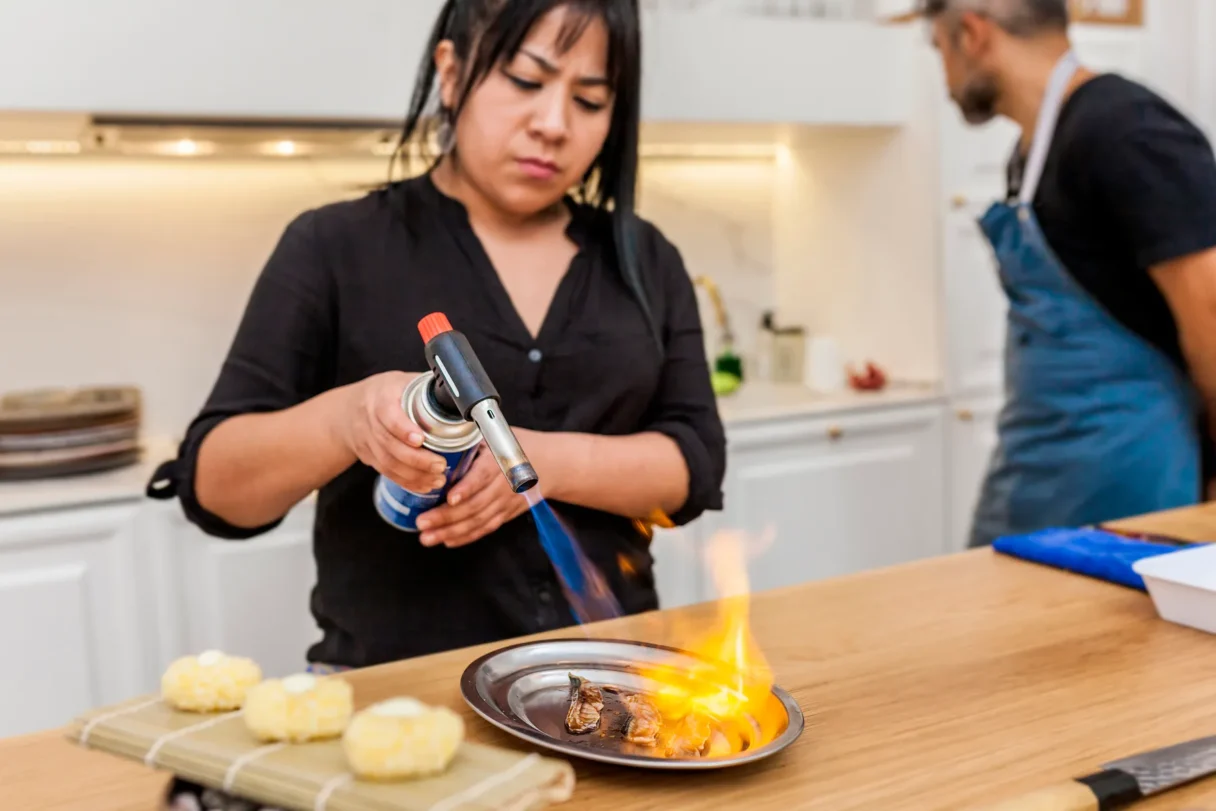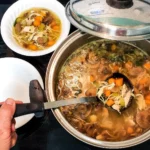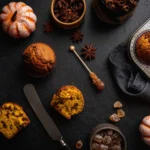
The Ultimate Cooking Techniques List for Every Kitchen
Introduction
This is the essential cooking techniques list that each professional chef and amateur cook should know. This comprehensive compilation will examine a variety of cooking techniques, spanning from rudimentary to sophisticated, which have the potential to revolutionize your culinary endeavors. Whether you are an experienced professional aiming to refine your skills or an amateur aspiring to gain knowledge, this guide provides invaluable perspectives to assist you in navigating the realm of cuisine. You can tap into your culinary prowess and prepare delicious meals that inspire pleasure on the tongue and senses.
Sautéing
Understanding the Basics:
Sautéing is a quick way to cook food over high heat that locks in the flavors. It usually means cooking food over high heat in a small amount of oil or fat.
The Right Pan:
You can pick a wide and small pan. If you want to sauté, don’t use non-stick pans because they might not be able to handle the high heat.
Heat Management:
Before you add the cooking fat, could you make sure the pan is hot? You can add your food when the fat is hot and shimmering.
Don’t Crowd the Pan:
Ensure there is only a little space between the items when adding them.
Too many people in a room can make food steam instead of sauté.
Stir Frequently:
To ensure that the food cooks evenly and avoids sticking to the pan, it is essential to keep it moving.
Grilling
Understanding the Basics:
The direct heat of a grill is used to cook food. The food is put on a grill rack above a heat source, like smoke or gas.
Choosing Your Grill:
Which grill do you choose? It depends on your taste. Gas grills heat up fast and make it easy to control the temperature. Charcoal grills, on the other hand, take longer to heat up but give food a unique smoky flavor.
Prepping Your Grill:
Please ensure your grill is clean and well-oiled to keep food from sticking. Before you start cooking, heat the grill.
Managing Heat Zones:
You can set up your grill with different heat zones for better control. If you want to sear and cook quickly, use the direct heat zone. For slow, even cooking, use the indirect heat zone.
Checking Doneness:
To ensure your meat is done, always use a meat thermometer. This keeps the meat from getting too done and ensures it’s cooked safely.
Roasting
Understanding the Basics:
When roasting, you can cook big pieces of meat or a bird with dry heat. It means cooking food in the oven in a pan that is not covered.
Selecting the Right Roasting Pan:
You can pick a strong pan that can be heated in the oven. Food shouldn’t be crammed into the pan, but it shouldn’t be so big that the juices spread out and burn.
Preheating the Oven:
It is essential to heat the oven before putting the food in it. This guarantees that the food will begin cooking immediately and the temperature will stay the same.
Seasoning Your Food:
Before you cook your food, remember to season it. Usually, a mix of salt, pepper, and herbs is used for this. You can also use a sauce or a dry rub to improve the taste.
Checking the Temperature:
Get a good meat thermometer to see if your roast is done. To get a correct reading, put it into the most challenging part of the meat and stay away from the bone.
Steaming
Understanding the Basics:
To steam food, use moist heat and let the hot steam rise from boiled water to cook the food. Although it doesn’t use oil, this way of cooking is healthy because it keeps the food’s nutritional value.
Choosing the Right Equipment:
Fit a pot with a lid that fits tightly on top of it. Then, use a bamboo steamer or a steamer pan. The food should be set up so steam can move around it quickly.
Maintaining Water Level:
The water level should be just right so the food doesn’t touch the bottom of the steamer basket. If you need to, could you add more hot water while the food is cooking?
Keeping the Lid Closed:
To keep the steam inside, keep the lid closed while you steam.
Be careful when you open the lid, though. Always open it away from you to avoid getting burned by the steam.
Checking Doneness:
Cooking times change based on what kind of food it is and how thick it is. To ensure the meat is done, use a fork to test for doneness or a thermometer to ensure the correct body temperature has been reached.
Braising
Understanding the Basics:
There are two steps to braising: brown the food over high heat, then simmer it in a liquid for a long time. It’s mainly used for more intricate cuts of meat that need to be simmered over low heat to get tender.
Choosing the Right Pot:
It would be best to have a heavy pot with a lid that fits tightly on top for braising to work. The pot should be big enough to hold the meat and the liquid but not so big that the liquid disappears quickly.
Searing Your Meat:
Add oil to a hot pan and brown your meat on all sides. This will keep the juices inside the meat and make it taste and look great.
Adding Your Liquid:
Once the meat has been seared, add enough liquid to reach halfway up the sides of the meat. The drink could be water, broth, wine, or a mix.
Low and Slow Cooking:
Could you place the pot on low heat and cover it? Let it cook slowly in an oven set to low heat. The tough connective tissue will be broken down if you simmer the meat. This will make the meat soft and tasty.
Stir-frying
Understanding the Basics:
Stir-frying is a quick way to cook food over high heat by constantly tossing and turning the food in a wok or frying pan. It is an integral part of many Asian dishes.
Choosing the Right Pan:
A wok is usually used for stir-frying because its sides are high and slope down, and its bottom is small. This is because it heats quickly and evenly. An extra-deep pan will work if you don’t have a wok.
Prepping Your Ingredients:
Cut the ingredients into small, even pieces so that they cook quickly and evenly. Before you start cooking, you should ensure that all your items are ready and easy to get to.
Managing the Heat:
Start with high heat to sear the food and bring out the taste. You can lower the heat during cooking to keep things from burning.
Adding Ingredients in Stages:
Things cook at different speeds. Most of the time, you should start with the things that take longer to cook, like meat and root vegetables, and add the things that cook faster, like leafy veggies and aromatics, at the end.
Poaching
Understanding the Basics:
This is a gentle, low-heat way to cook quickly broken foods like eggs, fish, and veggies. Putting food in a liquid that is just below boiling point is what it means.
Choosing the Right Liquid:
Usually, water, stock, or wine are used for poaching. The liquid can add flavor to the food. You can also add herbs and spices to make it taste better.
Maintaining Low Heat:
It’s essential to keep the heat low and steady when hunting. To ensure the food cooks slowly and holds its shape, the liquid should be hot but not boiling.
Submerging the Food Completely:
To guarantee that your food is cooked evenly, it must be thoroughly submerged in the poaching liquid.
Checking Doneness:
Poaching takes little time. Make sure your dish is done without overcooking. Set whites and runny yolks for poached eggs. Fish flesh should flake easily with a fork.
Baking
Understanding the Basics:
When you bake, the heat from the oven thoroughly cooks the food. The heat slowly spreads through the food, cooking it all the same way. It’s mainly used for cakes, pies, bread, and sweets.
Choosing the Right Equipment:
It would be best to have things like baking stones, sheets, or pans. Also often used are specialized tools such as muffin tins, loaf pans, and cake pans.
Preheating the Oven:
Preparing the oven is an essential part of baking. It keeps the oven at the same temperature the whole time, so the food cooks evenly.
Testing Doneness:
Depending on what it is, there are different ways to tell if something is done baking. If you stick a toothpick in the middle of a cake, it should come out clean. If you tap the bottom of the bread, it should sound hollow.
Cooling After Baking:
Could you wait a while after baking before cutting into what you made? This lets it set and makes cutting it easy. When baked goods like cookies and cakes cool on a rack, they don’t get mushy from the oven’s heat.
Conclusion
Finally, learning how to cook in different ways, like steaming, braising, stir-frying, boiling, and baking, can help you improve your cooking skills and give you more options in the kitchen. Each way has its process that works with different kinds of food and is meant to make textures, flavors, and smells that are all different. The important thing is to know how to use each method correctly based on the ingredients you have on hand. Have fun cooking!
Mary Johnson
Mary Johnson loves trying new recipes and teaching others. With years of cooking experience, she creates inspiring, delicious recipes. Her writing combines creativity and pragmatism, making cooking fun and easy for everyone.



